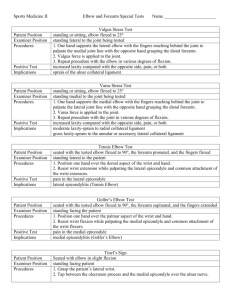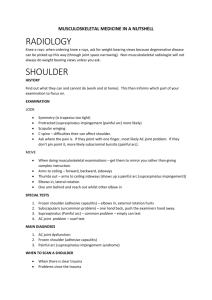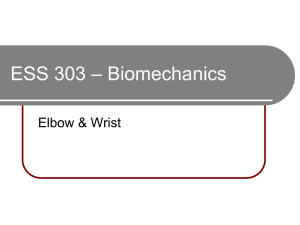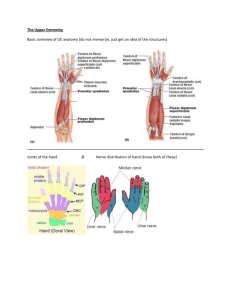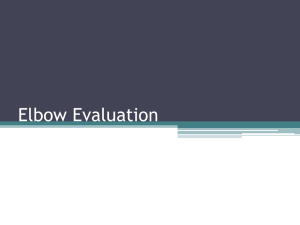Elbow Assessment
advertisement
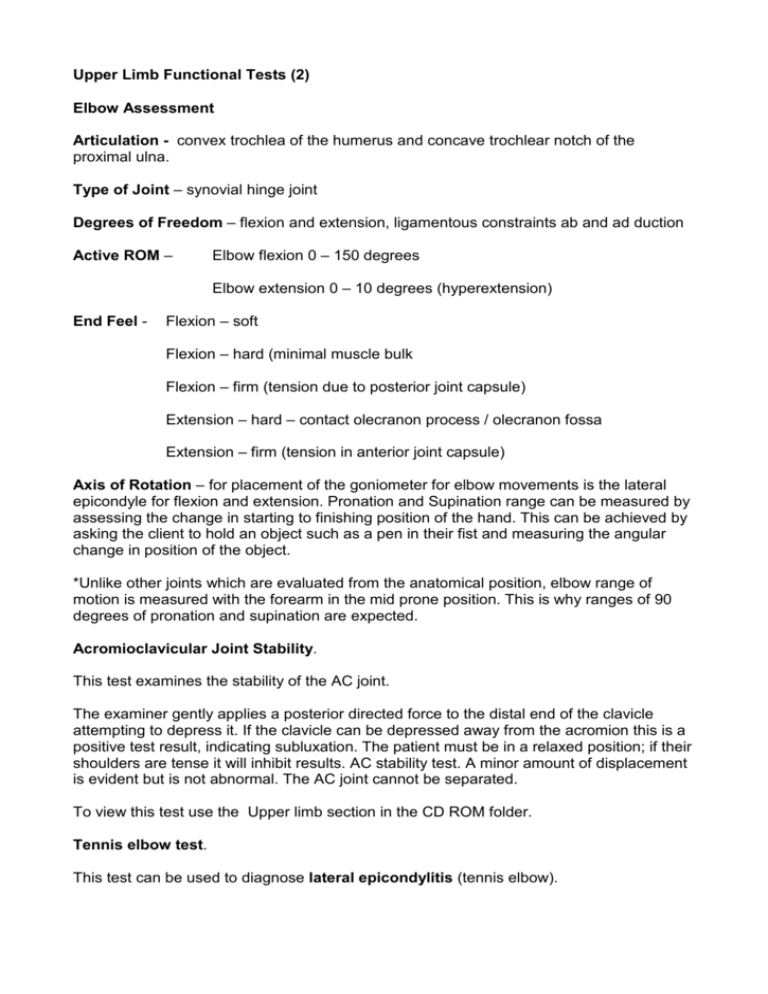
Upper Limb Functional Tests (2) Elbow Assessment Articulation - convex trochlea of the humerus and concave trochlear notch of the proximal ulna. Type of Joint – synovial hinge joint Degrees of Freedom – flexion and extension, ligamentous constraints ab and ad duction Active ROM – Elbow flexion 0 – 150 degrees Elbow extension 0 – 10 degrees (hyperextension) End Feel - Flexion – soft Flexion – hard (minimal muscle bulk Flexion – firm (tension due to posterior joint capsule) Extension – hard – contact olecranon process / olecranon fossa Extension – firm (tension in anterior joint capsule) Axis of Rotation – for placement of the goniometer for elbow movements is the lateral epicondyle for flexion and extension. Pronation and Supination range can be measured by assessing the change in starting to finishing position of the hand. This can be achieved by asking the client to hold an object such as a pen in their fist and measuring the angular change in position of the object. *Unlike other joints which are evaluated from the anatomical position, elbow range of motion is measured with the forearm in the mid prone position. This is why ranges of 90 degrees of pronation and supination are expected. Acromioclavicular Joint Stability. This test examines the stability of the AC joint. The examiner gently applies a posterior directed force to the distal end of the clavicle attempting to depress it. If the clavicle can be depressed away from the acromion this is a positive test result, indicating subluxation. The patient must be in a relaxed position; if their shoulders are tense it will inhibit results. AC stability test. A minor amount of displacement is evident but is not abnormal. The AC joint cannot be separated. To view this test use the Upper limb section in the CD ROM folder. Tennis elbow test. This test can be used to diagnose lateral epicondylitis (tennis elbow). With the patients arm resting upon a bench, the patient is instructed to clench their fist and actively extend their wrist joint. Once full active extension is reached the examiner applies a flexion force to the wrist with the patient instructed to continue to extend the wrist to resist this force. A positive test - Pain will be produced over the lateral epicondyle. The reverse method, with the patient resisting an extension force, can be used to test for medial epicondylitis (golfer’s elbow) To see this test use the Upper limb section in the CD ROM folder. Ligamentous stability (elbow). As with knee ligament testing, valgus and varus forces may be applied to the elbow to test the integrity of the medial and lateral collateral ligaments of the elbow. The procedure is the same as that for medial and lateral knee ligament testing. Wrist and Hand Assessment This module applies concepts covered in earlier modules to assessment of the Wrist and Hand. The ability to thoroughly assess the wrist and hand will be paramount in any prosthetic or orthotic treatment of this region. The objectives of this module are to; • • Review relevant anatomy of the wrist and hand. Outline wrist and hand: o Clearance testing o Active, resisted and passive testing o Special tests: Neurological testing – including dermatome and myotome distributions Allen Test Bunnel-Litter Test Phalen Test Finkelstein Test Finger Flexor Test Prior reading: Prior to commencing this module it is suggested that you: • • • Revise anatomy of the wrist and hand. Clarkson, HM. (2005). Joint Motion and Function Assessment. Hoppenfeld, S. (1976). Physical Examination of the Wrist and Hand. In S. Hoppenfeld (Eds.), Physical examination of the spine and extremities. Wrist and Hand Assessment The hand is the most active part of the upper limb and it's finely balanced complex of joints and muscles is integral to most everyday functions. Assessment of the wrist and hand is complex due to the large number of articulations and active muscles in this region. Common deficits encountered that may require orthotic management will include flexion contractures, fractures and overuse injuries. Prosthetic treatment at this level is less common as amputations do not occur as often in this area and patients often maintain high levels of function with the residuum and do not seek prosthetic replacements. Assessment of the upper limb involves understanding the function of the hand and also the ability of the arm to place the hand where it needs to be for optimal function. Articulation - biconcave surface formed by the radial facet and radioulnar disc with a biconvex surface consisting of the scaphoid, lunate and triquetrum Type of Joint – synovial ellipsoid joint Degrees of Freedom – flexion and extension Ulnar and radial deviation Active ROM – flexion 0 – 80 degrees extension 0 – 70 degrees ulnar deviation 0 – 30 degrees radial deviation 0 – 20 degrees End Feel - Flexion – firm Extension – firm (tension in palmar joint capsule) Extension – hard (radius contacts the carpal bones) Radial Deviation – hard (radial styloid contacts the scaphoid) Radial Deviation – firm (capsular tension) Ulnar Deviation – firm (capsular tension) Talk Observation Clearance Tests Use the CD ROM folder to review these clearance tests if needed. Touch The wrist and hand should be closely inspected with attention given to: Skin • • • • • • • • • • increased thickness may be abnormal texture - coarse, fine, dull, shiny colour callosities hair integrity dermatoses temperature elasticity humidity, dry, sweaty, areas of maceration Palpation • • • • Swelling Pain Structural abnormalities Temperature changes Bony landmarks • • • • • • distal ends of the radius and ulna carpal bones individual metacarpals and carpo-metacarpal joints metacarpal heads and metacarpo-phalangeal joints phalanges and inter-phalangeal joints observe thumb specifically Palpation of soft tissues • • • musculature in the hand – thenar and hyperthenar eminences, interossei identify the muscle tendons as they cross the wrist radial and ulnar arteries Active tests Resisted tests Passive tests Active movements such as grip and pinch patterns are commonly used to assess hand function as movement at all of the joints is contributing to the recorded range. Grip patterns • • • • Cylindrical Spherical Hook Lateral prehension Pinch patterns • • • Pad-to-pad Tip-to-tip Pad-to-side When assessing individual movements of the wrist and hand it is again important to ensure that movement at one joint only is being evaluated and that other regions are stabilised to prevent them from assisting the movement. Wrist • • • • • Pronation and supination 90 degrees* Flexion (palmar flexion) 85-90 degrees Extension (palmar dorsiflexion) 75-80 degrees Radial deviation 15-20 degrees Ulnar deviation 35-40 degrees Metacarpophalangeal. • • • • • Flexion -30/40-90 range/arc 120-130 Some lateral movement in extension but not in flexion Lateral deviation 20 Proximal interphalangeal 0-100 arc 100 Distal interphalangeal -10-90 arc 100 Thumb. • • • • Flexion arc 0-50 @MCP 20-90 @DIP Palmar Abduction 70 @MCP Palmar adduction 0 @MCP Grip patterns • • • • Cylindrical Spherical Hook Lateral prehension Pinch patterns • • • Pad-to-pad Tip-to-tip Pad-to-side Testing positions. Tests should be comfortably performed in either a sitting or standing position. Consideration of active and passive insufficiency will again be important as muscles cross both the wrist and hand joints. Ensure that joints which are not being tested are held in slight flexion. *pronation/supination range of motion is again measured with the forearm in a mid prone position rather than the anatomical position. Special tests. The following special tests can be conducted at the wrist and hand to aid in diagnosing any deficits. Allen Test. This test is used to establish if there is any inhibition of blood supply to the hand from the radial or ulnar artery. Procedure. Prior to commencing test; ask your patient to clench their fist a few times repeatedly. While the fist is closed pressure is applied to the radial and ulnar arteries by the examiner to block/occlude them by firmly applying pressure with the thumb and index finger at the patient’s wrist. The examiner maintains pressure upon the arteries, and the patient is asked to open their hand. The palm of the hand should be pale. The examiner then releases pressure from one of the arteries whilst maintaining pressure on the other. The palm should flush with blood immediately on the corresponding side. Repeat the test again releasing opposite artery. To view this test access it from the CD ROM folder Bunnel-Littler Test. This test can be used to distinguish if limited finger flexion range is due to the presence of tightness of the intrinsic muscles or of the PIP capsule. Procedure. Part 1. Position the MCP joint help in a few degrees of extension and support the finger in this position. Then attempt to flex the PIP joint by pressing down on the finger proximal to the DIP joint. (This procedure can be seen in stage one of the video below - in this example the patient performs the movement actively). Positive test: if the joint can not be flexed either the intrinsics are tight or there is a capsule contracture. (in the video below you will note that full flexion can be achieved - a negative test result) Part 2. To diagnose the cause of the restricted flexion allow the MCP joint to flex (relaxing the intrinsic muscles). If flexion can still not occur in this flexed position then the tightness is in the PIP capsule. If flexion can now occur then the tightness is in the intrinsic muscles. To view this test access it from the CD ROM folder Phalen Test. This test can be used to evaluate carpal tunnel compression (compression of wrist flexors). Procedure The objective of this test is to produce forced passive flexion. This can be done by the examiner in testing each wrist as part of the normal testing of passive range or can be performed by asking the patient to flex their wrists, place the dorsal surface of both hands together and then to attempt to push their wrists together. Positive test: pain will be produced in the carpal tunnel. Finkelstein Test. Tests for de Quervain’s syndrome (compression of wrist extensors, crepitus and inflammation of the extensor pollicus longus tendon) To view this test access it from the CD ROM folder Finger Flexor Tests. If there is an injury or weakness in the finger flexors then these tests can be used to distinguish if the deficit is in flexor digitorum profundis (DIP flexor) or flexor digitorum superficialis (PIP flexor). To view this test access it from the CD ROM folder Further special tests and illustrations of the above tests of the wrist and hand are also outlined in the Hoppenfeld text Shoulder and Elbow assessment. This module applies concepts of clinical assessment specific to the Shoulder and Elbow. The ability to thoroughly assess the upper limb is essential for both orthotic interventions such as orthoses for fracture injuries and prosthetics interventions where shoulder functions will play a major role in activating body powered prostheses. The objectives of this module are to; • • • Review relevant anatomy of the shoulder and elbow. Outline shoulder and elbow o Clearance testing o Active, resisted and passive testing Special tests o Neurological testing – including dermatome and myotome distributions o Empty Can Test o Impingement Test o Drop Arm Test o Apprehension Test o o o Acromioclavicular Joint Stability Tennis elbow test Ligamentous stability (elbow Prior reading: Prior to commencing this module it is suggested that you: • • • Revise anatomy of the shoulder complex and elbow joint Clarkson, HM. (2005). Joint Motion and Function Assessment. Chapter 3 and 4. Hoppenfeld, S. (1976). Physical examination of the spine and extremities. Chapter 1 Shoulder and Chapter 2 Elbow. Shoulder and Elbow Assessment. The shoulder complex exhibits large ranges of motion in multiple planes. Joints making up the complex are the three synovial joints Glenohumeral (GH), Sternoclavicular (SC), Acromioclavicular (AC) and the Scapulothoracic (ST) articulation which is a bone-musclebone articulation. Movement at the shoulder occurs through the combined movement of all of the above joints and is greater in range than any single joint within the shoulder complex. Movements of the GH and ST joints occur in a 2:1 ratio and can be further enhanced by movement of the trunk. Stability of the shoulder is the result of the soft tissue structures of the joint complex. Common deformities in this region include weakened/damaged musculature (especially the rotator cuff muscles) and dislocation of the joint. The elbow joint complex consists of three articulations, the Humeroulnar, Humeroradial and Radioulnar joints. The elbow region is more prone to fracture injuries and overuse syndromes, however, the joint itself is not commonly injured. Talk. Subjective assessment should detail relevant information about pain and stiffness patterns of the upper limbs and any impacts upon daily activities. Note any comments from your patient relating to pain or weakness in this area, previous medical or P&O treatment. Pay particular attention to any areas which may indicate care for the remainder of the assessment process, especially if the patient has had surgery or previous injuries to the shoulder or elbow joints. Observation. View patient undressing, and shake their hand as part of your introduction noting any awkward or painful movements. Analyse their gait and standing posture to determine if they are noticeably favoring one side. Patients with injured upper limbs will often lean to the affected side and hold that limb closer to their body. Clearance tests should cover With the examiner positioned to the side and the patient seated or standing test for: • • • Ask your patient to raise arm (abduct )from their side, flex their elbow and then place arm behind neck and scratch back. This test clears shoulder flexion, abduction and rotator cuff muscles and shoulder joint. Elbow flexors and elbow joint. Ask patient to reach across their body and touch opposite shoulder. This test clears shoulder adduction and internal rotation. Ask patient to fully flex or extend elbow and test ability to bring hand to mouth. This test clear elbow functions. Touch The shoulder and elbow region should be closely inspected with attention given to: Skin: • • • • • • • • • • increased thickness may be abnormal texture - coarse, fine, dull, shiny colour callosities hair integrity dermatoses temperature elasticity humidity, dry, sweaty, areas of maceration • Palpation o Swelling o Pain o Structural abnormalities o Temperature changes Bony landmarks Shoulder - the following bony prominences should be palpated; • • • • • • • • • suprasternal notch clavicle coracoid process acromioclavicular articulation acromion greater tuberosity of the humerus bicipital groove spine of the scapula vertebral border of the scapula Palpation of soft tissues • • • • • • • • • rotator cuff – Do you remeber the names of these muscles? sternocleidomastoid pectoralis major biceps brachii deltoid trapezius rhomboids latissimus dorsi serratus anterior Elbow Palpation of bony prominences • • • • • medial epicondyle and medial supracondylar line of the humerus olecranon and olecranon fossa lateral epicondyle and lateral supracondylar line medial epicondyle radial head Palpation of soft tissues • • • • • • • ulnar nerve common origin of wrist flexors triceps common origin of wrist extensors biceps brachii brachioradialis pronator teres Active tests Resisted tests Passive tests When assessing movements of the shoulder joint, always ensure that movement at one joint only is being evaluated. Be aware of accessory movements occurring around the joint being tested. It is important to distinguish between pure range (movement at one joint only) and total range (combined movements of joints). For example, you will need to prevent or monitor any movement of the scapula when assessing pure glenohumeral range. Do this by palpating the inferior angle of the scapula and watching for when it starts to contribute to the movement being assessed. Scapulo-thoracic movements elevation depression protraction retraction upward rotation downward rotation Glenohumeral movements flexion extension abduction adduction internal rotation external rotation The following ranges of shoulder motion would normally be expected. • Active ROM – Flexion 0-180 – Extension 0-60 – Abduction 0-180 (adduction?) – Internal Rotation – 0-70 – External Rotation – 0-90 – Horizontal Adduction – 0-40 – Horizontal Abduction – 0-90 Testing positions. Testing of the shoulder and elbow should be performed comfortably in either a sitting or standing position. The axis of rotation for placement of the goniometer for shoulder movements will vary according to the movement being tested. It is not always possible to align the goniometer with a bony landmark and often an estimation of the 'mid point' of the joint needs to be used Special tests. The following special tests can be conducted at the shoulder and elbow to aid in diagnosing any deficits. Empty Can Test. This test is used to evaluate any injury to the supraspinatus. Ask patient to abduct their arms to 90 degrees with the elbow fully extended. From this position then ask them to turn their thumbs to face the ground. The patient should be able to perform this movement without involving any glenohumeral movement. If weakness is present patient will elevate and internally rotate shoulder or may report pain on attempting movement. View the 'Empty-Can test' by using the Upper limb section in the CD ROM folder Impingement Test. This test assesses the integrity of supraspinatus tendon, long head of biceps tendon and bursa. Position patient’s shoulder in 90 degrees of abduction with elbow flexed to 90 degrees. Passively internally rotate the shoulder by supporting the arm and pushing down on the forearm. Pain will be experienced by the patient if any of the above structures are impinged by this movement. Examine the this by using the Upper limb section in the addition resources folder. Apprehension Test. This test assesses for dislocation of the GH joint. Position patient as for impingement test but passively externally rotate the shoulder and observe the patient for signs of discomfort. In the rotated position you can also apply an anteriorly directed force to the GH joint to assess if the joint is dislocatable. (As for Patella Apprehension Test take care not to actually dislocate the joint.) Examine the this test' by using the Upper limb section in the addition resources folder. Drop Arm Test This test assesses integrity of rotator cuff muscles. The examiner passively abducts the patient's arm to 90 degrees and then releases it. The patient is instructed to maintain this position or slowly lower their arm. If the patient can not hold the position or lower their arm smoothly from an abducted position, then this indicates a tear or weakness of the rotator cuff muscles. Use the Upper limb section in the CD ROM folder to examine this test. Neurological testing should be conducted by systematically by checking the following areas. Dermatomes - sensation of the following areas should be evaluated; C4 – superior shoulder to neck C5 – lateral arm to elbow C6 – lateral forearm, lateral palm, thumb and lateral half or 1st digit C7 – central palm and middle finger C8 – distal medial forearm, medial palm and 4th and 5th digits T1 – proximal medial forearm and distal medial arm T2 – proximal medial arm and auxilla Myotomes There are multiple overlaps in the myotome distributions for shoulder movements. At the elbow the following movements can be related to spinal levels: C5,6 - Elbow flexion and supination C7 – Elbow extension C6,8 and T1 - pronation Reflexes The following reflexes can be evaluated around the elbow Biceps reflex – C5 Triceps reflex – C7


